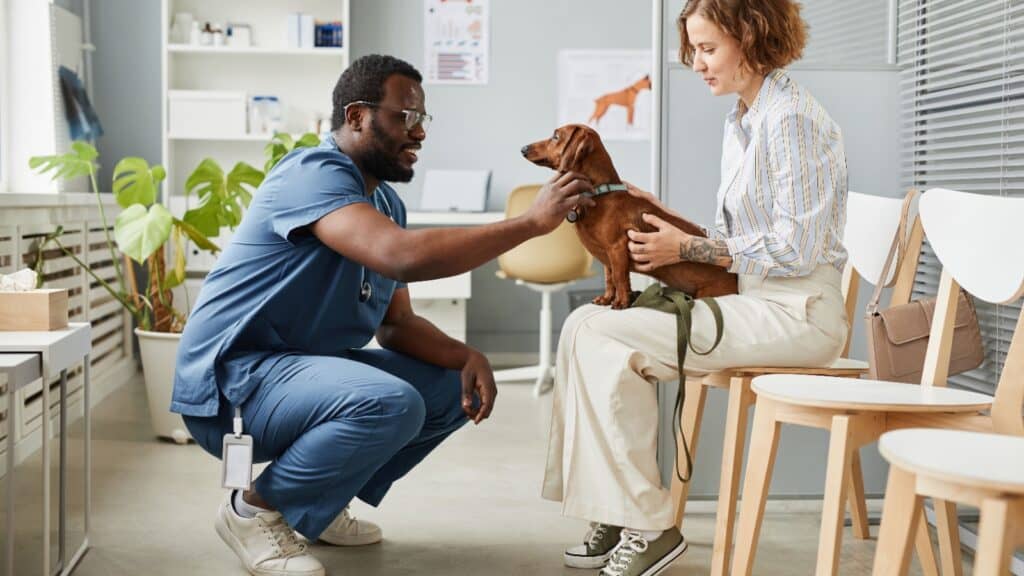Keep Your Dog’s Paws Safe: 4 Signs the Ground is Too Hot (Plus, First Aid If It’s Too Late!)
As a responsible pet owner, ensuring the safety and comfort of your dog is paramount, especially during hot weather. One crucial aspect to consider is the temperature of the ground. Hot pavement can cause severe burns to your dog’s paws, leading to pain, discomfort, and potential long-term damage. We show you 4 signs the ground is too hot; 4 preventative measures; 4 first aid tips; and 4 long-term care and awareness actions. Walking our dogs provides exercise and bonding time, but let’s do it safely!
4 Signs the Ground is Too Hot

- The Five-Second Rule: A simple and effective way to check if the pavement is too hot is to place the back of your hand on the ground for five seconds. If it’s too hot for you, it’s too hot for your dog.
- Paw Sensitivity: Dogs have sensitive paw pads that can burn easily. Watch for signs such as limping, refusing to walk, licking or chewing their paws, or visible burns and blisters.
- Temperature Considerations: On a 77°F (25°C) day, asphalt can reach temperatures of 125°F (51°C). When the temperature rises to 86°F (30°C), asphalt can hit 135°F (57°C). Always be cautious on sunny days.
- Behavioral Signs: If your dog is reluctant to walk or seems distressed when outside, it could be an indication that the ground is too hot.
4 Preventive Measures

This post may contain affiliate links. Please see our disclosure policy for details.
- Walk During Cooler Hours: Take your dog for walks early in the morning or late in the evening when the ground is cooler. Avoid midday walks when the sun is at its peak.
- Stay on Grass: Grass and dirt paths are usually cooler than asphalt and concrete. Whenever possible, walk your dog on these surfaces.
- Protective Gear: Invest in dog booties or paw wax. Booties provide a barrier between your dog’s paws and the hot ground, while paw wax can offer some protection against heat.
- Hydration: Always carry water for your dog to keep them hydrated. Dehydration can exacerbate the effects of heat.
4 First Aid for Burned Paws

- Cool the Paws: If you suspect your dog’s paws are burned, rinse them with cool water. Please refer to our article about cooling dogs down effectively.
- Check for Burns: Look for signs of burns such as redness, blisters, or peeling skin. If you notice these symptoms, seek veterinary care immediately.
- Avoid Walking: Keep your dog off hot surfaces and limit walking until their paws have healed.
- Protect and Treat: Use a pet-safe antiseptic and apply a protective covering, like gauze, to prevent infection and further injury.
4 Steps to Long-Term Care and Awareness

- Regular Paw Checks: Make it a habit to check your dog’s paws regularly, especially after walks. Early detection of any issues can prevent serious problems.
- Training and Conditioning: Train your dog to wear booties and condition them to walk on different surfaces gradually. This can help them adapt to various environments safely.
- Seasonal Awareness: Be mindful of seasonal changes and adjust your walking routine accordingly. Remember, even in cooler seasons, certain surfaces can retain heat.
- Time Your Walks: Make monitoring weather reports part of your regular routine.
The Takeaway

Protecting your dog’s paws from hot ground is an essential part of responsible pet ownership. By understanding the signs of hot pavement, taking preventive measures, and providing immediate care when needed, you can ensure your furry friend stays safe and comfortable all year round. Stay vigilant and always prioritize your dog’s well-being in any weather condition.
How To Protect Your Dog From Heat Stroke This Summer And What NOT To Do!

Summer is here and it’s essential to prioritize your dog’s safety and well-being by taking proactive steps to prevent overheating. Dogs are more susceptible to heat-related illnesses due to their inability to sweat like humans, making it crucial for pet owners to be aware of the signs, prevention methods, and emergency procedures to ensure their dog stays cool and healthy. In the most serious cases of canine dehydration, severe fluid shortage can lead to the failure of the kidneys and other organs.
In addition, we keep seeing posts, on Facebook in particular, that have incorrect, and even dangerous information. All of the information here is evidence-based.
READ: How To Protect Your Dog From Heat Stroke This Summer And What NOT To Do!
How Many Of These Foods Did You Know Could Kill Your Dog?

Our canine companions bring immense joy into our lives, and it’s our duty to ensure their well-being. However, certain everyday foods found in our homes can pose serious risks to their health. Here’s a look at foods that should never be fed to dogs or left within their reach.
To be prepared, have contact details of your local veterinarian, the nearest emergency clinic, and the ASPCA Animal Poison Control Center (888-426-4435) at hand. READ: How Many Of These Foods Did You Know Could Kill Your Dog?
Understanding The Surge In Veterinary Costs: Is It Becoming Too Expensive To Have A Pet?

If you own a pet, we bet you have noticed that veterinary care costs are escalating, leaving many of us with sticker shock and struggling to secure timely appointments. There are reasons for this burgeoning phenomenon; we unveil the many factors steering this surge. Read: Understanding The Surge In Veterinary Costs: Is It Becoming Too Expensive To Have A Pet?
Join Us

Join us on this empowering journey as we explore, celebrate, and elevate “her story.” The Queen Zone is not just a platform; it’s a community where women from all walks of life can come together, share their experiences, and inspire one another. Welcome to a space where the female experience takes center stage. Sign up for our newsletter so you don’t miss a thing, Queen!







